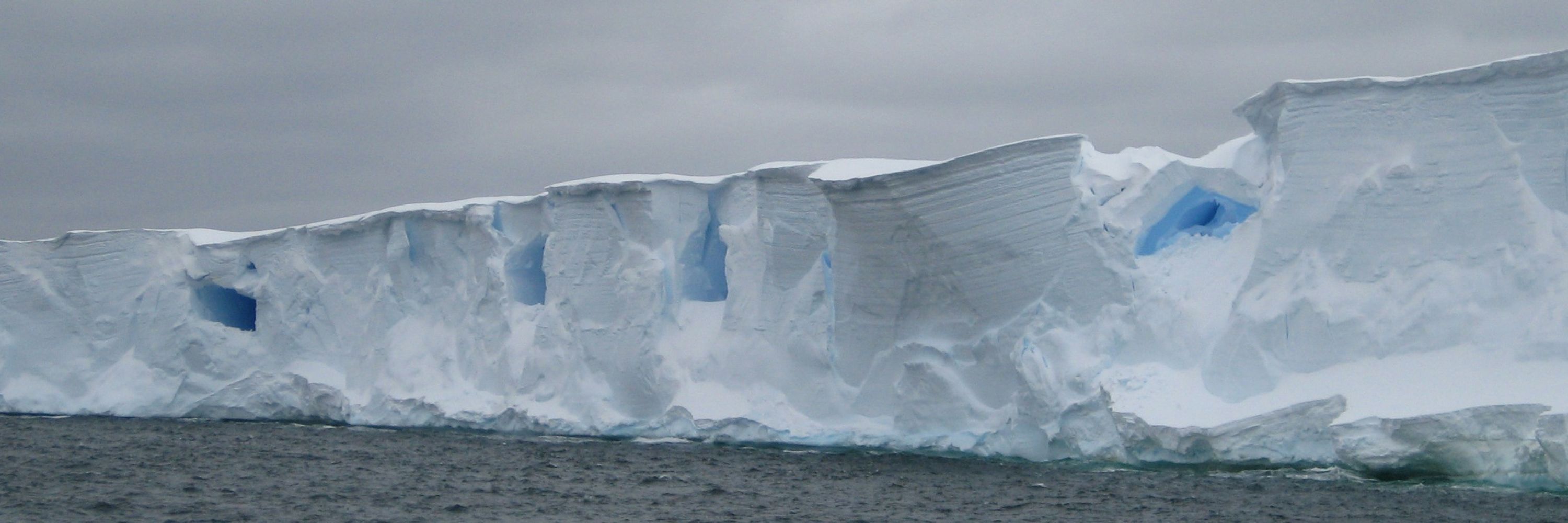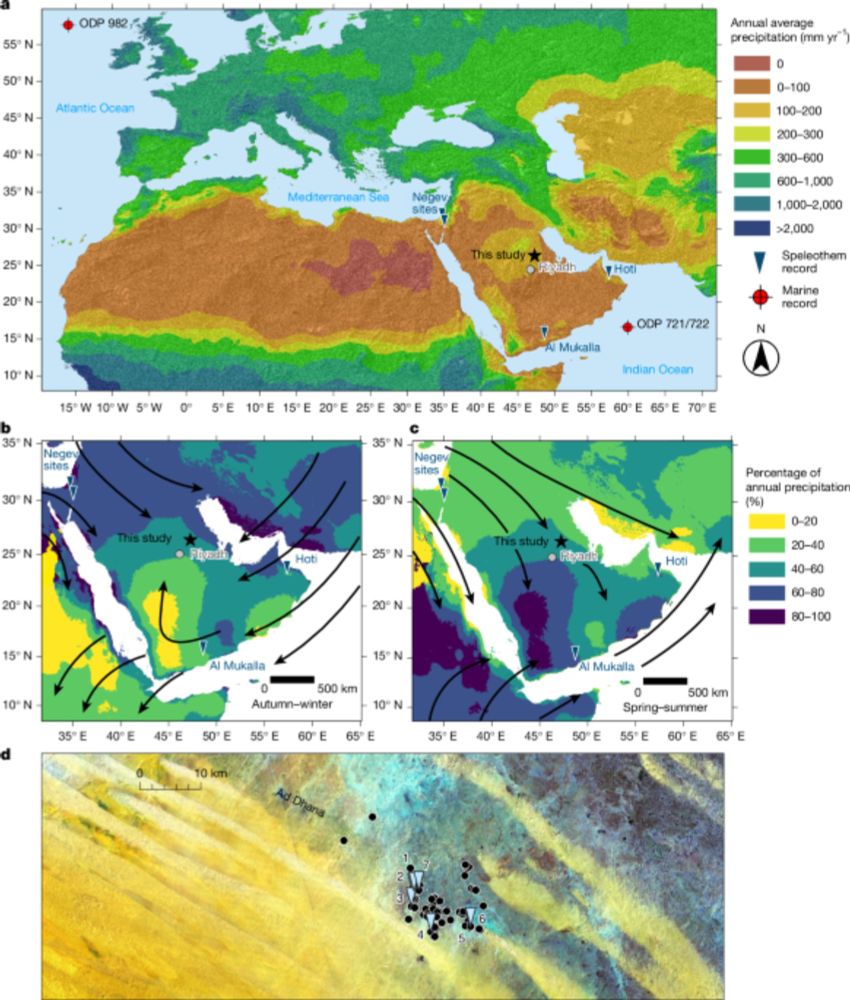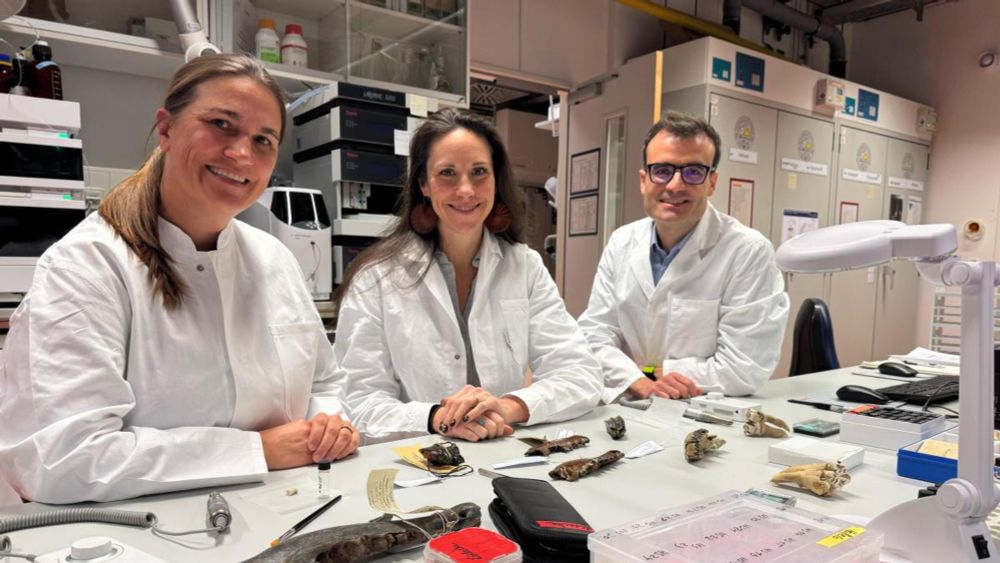
Alfredo Martínez García
@amglab.bsky.social
Isotope Geochemist at the Max Planck Institute for Chemistry
(https://www.theamglab.com/)
(https://www.theamglab.com/)
Pinned

Australopithecus at Sterkfontein did not consume substantial mammalian meat
Incorporation of animal-based foods into early hominin diets has been hypothesized to be a major catalyst of many important evolutionary events, including brain expansion. However, direct evidence of ...
www.science.org
Hot off the press, in a study published today in Science, we show that Australopithecus did not consume
substantial mammalian meat
www.science.org/doi/10.1126/...
substantial mammalian meat
www.science.org/doi/10.1126/...
Reposted by Alfredo Martínez García
Huge paper for the Arctic Ocean published today in @science.org - a new 30,000 year history of Arctic Ocean sea-ice cover reconstructed from the accumulation of cosmic dust-derived helium-3! www.science.org/doi/10.1126/... (1/n)

Cosmic dust reveals dynamic shifts in central Arctic sea-ice coverage over the past 30,000 years
Arctic sea-ice loss affects biological productivity, sustenance in coastal communities, and geopolitics. Forecasting these impacts requires mechanistic understanding of how Arctic sea ice responds to ...
www.science.org
November 7, 2025 at 1:08 AM
Huge paper for the Arctic Ocean published today in @science.org - a new 30,000 year history of Arctic Ocean sea-ice cover reconstructed from the accumulation of cosmic dust-derived helium-3! www.science.org/doi/10.1126/... (1/n)
Reposted by Alfredo Martínez García
Check out our latest work, led by Jon Jung, Ph.D. student in the @amglab.bsky.social at @mpic.de:
www.nature.com/articles/s41...
Here we show that the supply of excess phosphorous from accounts for the majority of observed Sargassum variability since 2011.
🌊 🧪 #Paleosky #CoralReefs
www.nature.com/articles/s41...
Here we show that the supply of excess phosphorous from accounts for the majority of observed Sargassum variability since 2011.
🌊 🧪 #Paleosky #CoralReefs

Equatorial upwelling of phosphorus drives Atlantic N2 fixation and Sargassum blooms - Nature Geoscience
High near-surface nitrogen-fixation rates that promoted the recent growth of the Great Atlantic Sargassum Belt were tied to greater upwelling of phosphorus from the equatorial Atlantic, according to c...
www.nature.com
November 6, 2025 at 1:10 PM
Check out our latest work, led by Jon Jung, Ph.D. student in the @amglab.bsky.social at @mpic.de:
www.nature.com/articles/s41...
Here we show that the supply of excess phosphorous from accounts for the majority of observed Sargassum variability since 2011.
🌊 🧪 #Paleosky #CoralReefs
www.nature.com/articles/s41...
Here we show that the supply of excess phosphorous from accounts for the majority of observed Sargassum variability since 2011.
🌊 🧪 #Paleosky #CoralReefs
Reposted by Alfredo Martínez García
Today, we published a study long in the making on how upper and subsurface tropical Pacific waters responded (and maybe will adjust) to warmer global climate. Here’s the story of how we got here after 15 years. many authors but shout out @jfarmersalmanac.bsky.social
🌊
www.science.org/doi/10.1126/...
🌊
www.science.org/doi/10.1126/...

Persistent eastern equatorial Pacific Ocean upwelling since the warm Pliocene
Upwelling generates a nutrient-rich “cold tongue” in the eastern equatorial Pacific Ocean (EEP), with impacts on global climate, oceanic biological productivity, and the carbon cycle. The cold tongue ...
www.science.org
October 3, 2025 at 12:04 AM
Today, we published a study long in the making on how upper and subsurface tropical Pacific waters responded (and maybe will adjust) to warmer global climate. Here’s the story of how we got here after 15 years. many authors but shout out @jfarmersalmanac.bsky.social
🌊
www.science.org/doi/10.1126/...
🌊
www.science.org/doi/10.1126/...
Reposted by Alfredo Martínez García
Another cool paper coming out of @amglab.bsky.social. Led by Tanja Wald, here we present basin-wide profiles of Mediterranean nitrate N/O isotopes, and show that this distribution can be explained by a combination of nitrogen fixation and anthropogenic nitrogen deposition: dx.doi.org/10.1029/2023...

Origins of the Nitrate 15N Depletion in the Mediterranean Sea
Basin-wide depth profiles of nitrate δ15N and δ18O indicate a supply of low-δ15N N to the Mediterranean Sea Nitrate δ15N can be explained by modest rates of N2 fixation and/or anthropogenic N dep...
dx.doi.org
June 26, 2025 at 7:46 AM
Another cool paper coming out of @amglab.bsky.social. Led by Tanja Wald, here we present basin-wide profiles of Mediterranean nitrate N/O isotopes, and show that this distribution can be explained by a combination of nitrogen fixation and anthropogenic nitrogen deposition: dx.doi.org/10.1029/2023...
Reposted by Alfredo Martínez García
Just published open-access in @agu.org's Paleo Paleo: A new foraminifera-bound nitrogen isotope perspective on one of geology's evergreen mysteries: The history of the Central American Seaway agupubs.onlinelibrary.wiley.com/doi/full/10.... (1/a few)...

Early Pliocene Shoaling of the Central American Seaway Reconstructed From Foraminifera‐Bound Nitrogen and Oxygen Isotopes
Foraminifera-bound nitrogen isotopes trace the early Pliocene restriction of nutrient exchange across the Central American Seaway Geochemical data indicate four phases of seaway shoaling between ...
agupubs.onlinelibrary.wiley.com
April 18, 2025 at 12:58 AM
Just published open-access in @agu.org's Paleo Paleo: A new foraminifera-bound nitrogen isotope perspective on one of geology's evergreen mysteries: The history of the Central American Seaway agupubs.onlinelibrary.wiley.com/doi/full/10.... (1/a few)...
Reposted by Alfredo Martínez García
(1/13) A thread on our new paper just published in Nature, ‘Recurrent humid phases in Arabia over the past 8 million years’. www.nature.com/articles/s41...

Recurrent humid phases in Arabia over the past 8 million years - Nature
A climatic record from desert speleothems shows that the central Arabian interior experienced recurrent humid intervals over the past 8 million years, which likely facilitated mammalian dispersals bet...
www.nature.com
April 9, 2025 at 3:22 PM
(1/13) A thread on our new paper just published in Nature, ‘Recurrent humid phases in Arabia over the past 8 million years’. www.nature.com/articles/s41...
Reposted by Alfredo Martínez García
A mammoth effort from all involved. Great to see this published. bg.copernicus.org/articles/22/...

Reviews and syntheses: Review of proxies for low-oxygen paleoceanographic reconstructions
Abstract. A growing body of observations has revealed rapid changes in both the total inventory and the distribution of marine oxygen over the latter half of the 20th century, leading to increased int...
bg.copernicus.org
February 18, 2025 at 10:30 AM
A mammoth effort from all involved. Great to see this published. bg.copernicus.org/articles/22/...
Listen to Tina Lüdecke explaining our latest @science.org
paper investigating the diet of our ancient hominin relatives Australopithecus on the Science Podcast:
www.science.org/content/podc...
paper investigating the diet of our ancient hominin relatives Australopithecus on the Science Podcast:
www.science.org/content/podc...

Rising infections from a dusty devil, and nailing down when our ancestors became meat eaters
On this week’s show: Climate change may be driving an expansion of Valley fever, a deadly fungal infection spread by desert-loving spores, and a look at <em>Australopithecus</em>’s diet 3 million year...
www.science.org
January 18, 2025 at 3:31 PM
Listen to Tina Lüdecke explaining our latest @science.org
paper investigating the diet of our ancient hominin relatives Australopithecus on the Science Podcast:
www.science.org/content/podc...
paper investigating the diet of our ancient hominin relatives Australopithecus on the Science Podcast:
www.science.org/content/podc...
Reposted by Alfredo Martínez García
Excited to share our latest research published in @science.org #ScienceAdvances! 🎉
We've discovered the Laacher See eruption 🌋 in a speleothem from Germany, which allows to synchronize European and Greenland Late Glacial climate change.
Read more: www.science.org/doi/10.1126/...
A Thread ⬇️⬇️ 1/n
We've discovered the Laacher See eruption 🌋 in a speleothem from Germany, which allows to synchronize European and Greenland Late Glacial climate change.
Read more: www.science.org/doi/10.1126/...
A Thread ⬇️⬇️ 1/n

Discovery of Laacher See eruption in speleothem record synchronizes Greenland and central European Late Glacial climate change
A volcanic sulfur spike links the Laacher See eruption to Greenland ice cores and synchronizes the timelines to European records.
www.science.org
January 16, 2025 at 10:42 AM
Excited to share our latest research published in @science.org #ScienceAdvances! 🎉
We've discovered the Laacher See eruption 🌋 in a speleothem from Germany, which allows to synchronize European and Greenland Late Glacial climate change.
Read more: www.science.org/doi/10.1126/...
A Thread ⬇️⬇️ 1/n
We've discovered the Laacher See eruption 🌋 in a speleothem from Germany, which allows to synchronize European and Greenland Late Glacial climate change.
Read more: www.science.org/doi/10.1126/...
A Thread ⬇️⬇️ 1/n
Hot off the press, in a study published today in Science, we show that Australopithecus did not consume
substantial mammalian meat
www.science.org/doi/10.1126/...
substantial mammalian meat
www.science.org/doi/10.1126/...

Australopithecus at Sterkfontein did not consume substantial mammalian meat
Incorporation of animal-based foods into early hominin diets has been hypothesized to be a major catalyst of many important evolutionary events, including brain expansion. However, direct evidence of ...
www.science.org
January 16, 2025 at 8:17 PM
Hot off the press, in a study published today in Science, we show that Australopithecus did not consume
substantial mammalian meat
www.science.org/doi/10.1126/...
substantial mammalian meat
www.science.org/doi/10.1126/...
You can find a link for free access to our latest Science paper (Decadal oscillations in the ocean’s largest oxygen-deficient zone) in my website (www.theamglab.com/publications)

December 13, 2024 at 9:39 AM
You can find a link for free access to our latest Science paper (Decadal oscillations in the ocean’s largest oxygen-deficient zone) in my website (www.theamglab.com/publications)
Reposted by Alfredo Martínez García
Congrats to @climatereefs.bsky.social colleague Nic Duprey of the @amglab.bsky.social on his publication in Science
Hot off the (e-)press, a study in Science led by Nic Duprey showing that the variability of the world's largest Oxygen Deficient Zone over the last 80 years is tightly linked to Pacific Decadal Variability: www.science.org/doi/10.1126/...

Decadal oscillations in the ocean’s largest oxygen-deficient zone
The impact of global warming on the ocean’s oxygen-deficient zones (ODZs) is uncertain, partly because of a lack of data on past changes. We report monthly resolved records of coral skeleton–bound nit...
www.science.org
December 5, 2024 at 12:24 PM
Congrats to @climatereefs.bsky.social colleague Nic Duprey of the @amglab.bsky.social on his publication in Science
Reposted by Alfredo Martínez García
Lots of cool science on corals coming out of the @amglab.bsky.social at the moment, with #SPP2299 colleagues involved
We've had a couple cool things come out of the lab lately, and I wanted to share. First, check out this paper from Jon Jung et al. in Nature showing geochemical evidence for coral symbiosis on Devonian reefs: www.nature.com/articles/s41...

Coral photosymbiosis on Mid-Devonian reefs - Nature
Nitrogen isotope evidence of Mid-Devonian photosymbiotic associations in certain types of corals suggests that autotrophic and heterotrophic corals co-existed on extinct reefs, as today, but in w...
www.nature.com
December 5, 2024 at 12:34 PM
Lots of cool science on corals coming out of the @amglab.bsky.social at the moment, with #SPP2299 colleagues involved
Reposted by Alfredo Martínez García
More cool science on corals coming out of the @amglab.bsky.social at the moment, with #SPP2299 colleagues involved
Last, a set of observations detailing a massive cold-bleaching and mortality event of mesophotic reefs that we observed in 2023 onboard S/Y Acadia at Clipperton Atoll in the Eastern Tropical Pacific:
www.sciencedirect.com/science/arti...
www.sciencedirect.com/science/arti...

Severe cold-water bleaching of a deep-water reef underscores future challenges for Mesophotic Coral Ecosystems
Elevated sea surface temperatures are causing an increase in coral bleaching events worldwide, and represent an existential threat to coral reefs. Ear…
www.sciencedirect.com
December 5, 2024 at 12:36 PM
More cool science on corals coming out of the @amglab.bsky.social at the moment, with #SPP2299 colleagues involved
Reposted by Alfredo Martínez García
Ever wanted to get just a little bit more out of your lipid extracts when measuring compound specific isotopes?
If yes, here's a new paper that might be of interested to you:
analyticalsciencejournals.onlinelibrary.wiley.com/doi/10.1002/...
with @amglab.bsky.social
If yes, here's a new paper that might be of interested to you:
analyticalsciencejournals.onlinelibrary.wiley.com/doi/10.1002/...
with @amglab.bsky.social

Large‐Volume Injection and Assessment of Reference Standards for n‐Alkane δD and δ13C Analysis via Gas Chromatography Isotope Ratio Mass Spectrometry
Rationale
Compound-specific stable isotope analysis of hydrogen (δD) and carbon (δ13C) in organic compounds is a valuable tool in biogeochemical research. A key limitation of this method is the rela.....
analyticalsciencejournals.onlinelibrary.wiley.com
December 5, 2024 at 3:43 AM
Ever wanted to get just a little bit more out of your lipid extracts when measuring compound specific isotopes?
If yes, here's a new paper that might be of interested to you:
analyticalsciencejournals.onlinelibrary.wiley.com/doi/10.1002/...
with @amglab.bsky.social
If yes, here's a new paper that might be of interested to you:
analyticalsciencejournals.onlinelibrary.wiley.com/doi/10.1002/...
with @amglab.bsky.social








